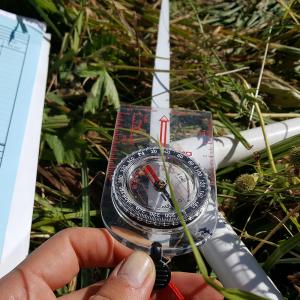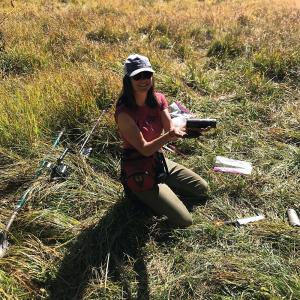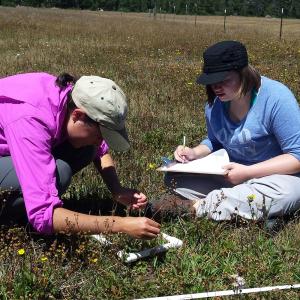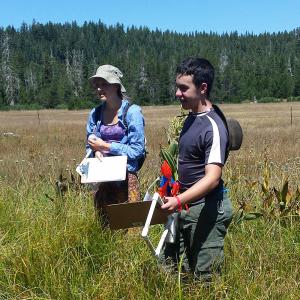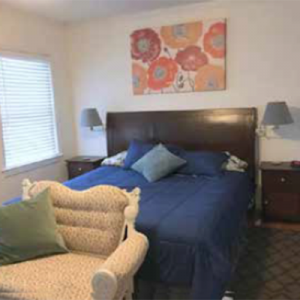.
Please read the following information before leaving for your expedition.
It provides the most accurate information available and will likely answer any questions you have about the project. You may also reach out to your Program Coordinator with any questions you may have.
.
.
Restoring Sierra Meadows: The Source of California’s Water
Expedition Briefing
Click on the images to view full size!
COVID-19 Safety
Please test for COVID-19 before traveling to your expedition; do not travel if you have tested positive, and call Earthwatch right away for the next steps. Visit earthwatch.org/covid-19 for more information on how you can help reduce the risk of COVID-19 impacting your expedition.
The Research
Each spring, melting snowpack flows from the Sierra Nevada Mountains, which run 400 miles long and 50 miles wide across eastern California. Some of this water is captured as groundwater by meadows before flowing into California’s Central Valley. These meadows function like sponges, collecting runoff during periods of snowmelt and high rainfall and reducing downstream flooding. Meadows collect and store water and act as natural filters by removing excess sediment and nutrients. Streams that run through meadows slowly drain them, releasing clean water late into the summer and fall when it is needed most. The Sierra Nevada Mountains provide two-thirds of the water supply in California—a state experiencing the worst drought in recorded history.
These delicate ecosystems have been altered by human activities, including grazing cattle that can alter the landscape, climate change (Blankinship and Hart 2014), mining, and fire suppression. These factors can influence meadows in the region by introducing invasive species, degrading streams, and altering the tree species that border the meadows (Ratliff 1985).
Meadows are typically flat areas dominated by grass and flowers, with few woody plants, such as shrubs and trees. Meadows are open, sunny, and often wet, characteristics that attract flora and fauna that could not survive in other areas of the watershed. In a healthy meadow, the edges are typically lined with leafy aspen stands. But as human activities change the landscape, conifers—trees that often outcompete aspens for water and sunlight—have begun to encroach upon the edges. Aspen is an important part of Sierra meadows because they support a unique assemblage of plant species.
Assessing the response of meadow habitat to these alterations is an important step towards understanding how grazing, mining, and fire suppression have changed the size and function of each meadow and increased susceptibility to our changing climate.
Restoring Sierra Meadows: The Source of California’s Water
Research Aims
The goal of the Tahoe National Forest and South Yuba River Citizens League’s (SYRCL’s) Sierra Meadows project is to quantify the benefits of meadow restoration actions on groundwater and surface water, vegetation establishment, aspen recruitment, carbon sequestration, and greenhouse gas emissions within the Yuba River watershed. We expect that these efforts will contribute significantly to the body of knowledge about Sierran Meadows.
Over the last five years, the meadow restoration projects on the Tahoe National Forest have grown substantially. In partnership with SYRCL, the Tahoe National Forest is now in the process of restoring over 1,000 acres within 7 meadows in the Yuba watershed. We are currently collecting baseline data in newer projects that have yet to be restored, as well as conducting post-restoration data collection in projects that have been completed. This data helps us understand the current state of the meadows and helps identify how specific meadow attributes (like groundwater level or degree of conifer encroachment) respond to restoration actions after projects are complete.
Restoring meadows by improving removing conifers and repairing stream channel conditions is critical to the improvement of meadow ecosystem function, habitat health, and carbon sequestration. Each restoration project requires baseline and post-restoration monitoring to answer the following research questions:
- Is conifer encroachment more common or denser in meadows with impaired hydrology or where fire suppression practices have been in place?
- Are aspens returning to areas where conifers have been removed? Do restoration actions raise groundwater levels and overall meadow soil moisture within the meadow?
- Will meadow vegetation become denser and more dominated by wetland species after restoration actions occur?
- What is the carbon budget for different plant communities and hydrologic regimes within our study meadows?
- Do groundwater levels within the meadow drive what types of vegetation occur in our study meadows or how much conifer encroachment there is?
- How will vegetation, hydrologic regime, soil organic matter content, and GHG emissions change in response to meadow restoration activities?
- Will we see more carbon being sequestered within meadows before or after restoration?
Restoring Sierra Meadows: The Source of California’s Water
How You Will Help
Each day, you will work with a small group to survey the stream channels, measure groundwater levels, vegetation density, tree density, soil carbon, or aid in restoration activities within a meadow. You will be trained in all methods and will be supervised by a trained scientist throughout the entire duration of your expedition. After an initial orientation and introduction to the research tasks, you will receive daily basic training to ensure you and your team are comfortable and confident in accomplishing the tasks required of you and understand why the tasks are necessary to address the research objectives of this project.
- Streamline Evaluations: Streamline evaluations will be conducted by walking the middle line of the stream and taking cross-section measurements and water depth within the streambed. At some locations, stream velocity may be measured using a flow meter.
- Vegetation Density and Biomass: Vegetation sampling will include sampling within plots to identify all plants and how frequently they occur within the meadow. Additionally, we will be collecting clippings of the vegetation plots to determine above ground carbon content of plants and to conduct an invasive species removal experiment.
- Groundwater Measurement: Groundwater measurements will include measuring water depth within groundwater wells. You may also be assisting with installing groundwater wells.
- Tree Plots Transects Aspen and conifer transects and plots will be established within and adjacent to meadows, and trees will be identified and measured.
Restoring Sierra Meadows: The Source of California’s Water
Life in the Field
In the first two days of the expedition, you will receive an introduction to the research and a safety briefing. During the expedition, you will collect data in meadows near the upper sections of the South Yuba River and Donner Summit in the Tahoe National Forest. In addition to collecting data, you will also be given lectures on topics such as water use in California water and the ecology of meadows and forests. Additionally, you will watch an environmental film focused on water issues that was featured at SYRCL’s Wild and Scenic Film Festival.
In the setting of ecological field research, there is often a blurry line between work and play. The “work” can be quite enjoyable, and some participants have found it to be a life-changing experience. You will most likely experience a steep learning curve over the first few days of the project and will be pleasantly surprised at how much you have learned and accomplished by the end of the project.
DAILY ACTIVITIES
Weather and research needs can lead to changes in the daily schedule. We appreciate your cooperation and understanding.
While there is no typical day in the field, our ‘typical’ day will be: Breakfast, a briefing of the work to be done for the day, the safety considerations involved with the work, and how the scientists will be using the data we will be collecting. We will follow this up by assembling our field gear, preparing and packing our lunches, and heading into the field. We will collect scientific data to assess streamlines by measuring water depth and velocity, vegetation transects by walking a straight line and recording all the flower and grass species you encounter, groundwater well depth by measuring water depths, soil samples for quantifying soil carbon and soil density, and aboveground plant biomass for establishing carbon budgets. We will have lunch in the field and complete our fieldwork before heading back to the field station to add our data to the database and debrief. After a downtime for journaling, hiking, taking pictures, or hanging out, we will have dinner and listen to a research talk or watch a wild and scenic film.
ITINERARY
Day 1: Arrival
- Arrive at either Reno or Sacramento International Airport (TBD)
- Travel to accommodations (approximately a one-hour drive)
- Settle into the accommodations, group dinner, introduction to the research
Day 2: Introduction
- Travel to Van Norden, Loney or North Yuba Meadows
- Training on research tasks in a meadow: flower/grass transects, tree measuring, groundwater well monitoring, carbon sequestration monitoring.
Days 3-7: Data Collection
- Data collection in meadows across the North & South Yuba drainage basin
- Flower and grass transects, groundwater measurements, soil sampling, biomass sampling.
- Evening lectures and videos
- Student presentations on the research
- You will also have a recreational day to take a break from research and do a group activity.
Day 8: Departure
- Depart accommodations (approximate a one-hour drive)
- Drop off at either Reno or Sacramento International Airport (TBD)
Restoring Sierra Meadows: The Source of California’s Water
Accommodations and Food
Teams will stay in a comfortable rental home. The house has hot water and electricity. There is a shared kitchen, spacious common areas, and an outdoor patio.
SLEEPING
You’ll sleep in rooms furnished with double, queen, and twin beds. Bedding is provided.
* Earthwatch will honor each person’s assertion of gender identity respectfully and without judgment. For both teen and adult teams, where logistics dictate single-sex accommodations or other facilities, participant placements will be made in accordance with the gender identity the participant specified on their Earthwatch Participant form and/or preferences indicated in discussions with Earthwatch.
BATHROOMS
There are shared bathrooms and showers at the accommodation. Please bring a bath towel.
ELECTRICITY
You are welcome to bring your own electronic equipment (cell phone, digital camera, laptop, etc.), but you will be required to limit your use of cell phones or laptops to recreational time only.
PERSONAL COMMUNICATIONS
Free Wi-Fi might be available at the accommodations. Cell phone reception is spotty in the area.
Please note: The Girls in Science Fellowship allows fellows to fully immerse themselves in the program by interacting with the beautiful natural setting of their awarded expedition and connecting with their peers and the scientists. While photos and videos in the field are acceptable, Earthwatch encourages volunteers to immerse themselves in the experience by avoiding outgoing calls, texts, and social media presence during group activities, including fieldwork and facilitated activities; likewise, family and friends should restrict calls to urgent messages only. Program staff will designate times for contacting home if cell service or Wi-Fi is available. Outside of those designated times, we ask that you adhere to the Teen Behavior Agreement regarding technology use and avoid any non-urgent contact to others outside the expedition.
DISTANCE TO FIELD SITE
Your team will travel to the general location of the research sites by van. Then, the team will walk on a trail to the road to the meadow, no more than two miles.
FOOD AND WATER
Cold breakfasts will be provided, as the team will be out in the field early. You will typically be out for the entire day, so each person will prepare his or her own bagged lunch to take along. The research staff will provide water to refill participant’s personal water bottles. We do not provide water bottles.
The following are examples of foods you may find in the field. Variety depends on availability. We appreciate your flexibility.
TYPICAL MEALS
- Breakfast: Oatmeal, cereal, toast, muffins, yogurt, or fresh fruit.
- Lunch: Bag lunches: sandwich fixings, fruit, chips, snacks, etc.
- Dinner: Classic American food
- Beverages: Juice, milk, iced tea, hot tea, coffee, water.
SPECIAL DIETARY REQUIREMENTS
Please alert Earthwatch to any special dietary requirements (e.g., diabetes, lactose intolerance, nut or other food allergies, vegetarian or vegan diets) as soon as possible, and note them in the space provided on your volunteer forms.
We can cater for vegetarian diets easily, as well as vegan, gluten-free, and lactose-free diets.
Restoring Sierra Meadows: The Source of California’s Water
Project Conditions
The information that follows is as accurate as possible, but please keep in mind that conditions may change.
July to September is typically very sunny, but afternoon thunderstorms are possible. The meadows in which you will work can be buggy and muddy. The evenings can be very cold at the station, even in the middle of summer. Rain is uncommon, but afternoon thunderstorms are possible.
GENERAL CONDITIONS
For weather and region-specific information, please visit Wunderground.com and search for your project location.
Restoring Sierra Meadows: The Source of California’s Water
Essential Eligibility Requirements
All participants must be able to:
- Enjoy working as a team and functioning cohesively within a group.
- Independently follow verbal or visual instructions.
- Enjoy being outdoors all day in all types of weather, including high temperatures but usually low humidity.
- Walk over uneven, forested, mountainous, or hilly terrain for two to four hours for three to five miles per day, often in high temperatures.
- Enjoy being outdoors in the potential presence of wild animals, snakes, and insects.
- Carry personal daily supplies, such as lunch, water, and a camera.
- Tolerate working at high altitudes.
- Get low enough to access and collect samples on the ground and in the brush.
- Sit and ride, with seatbelt fastened, in project vehicles for up to approximately three hours per day.
- Follow verbal and/or visual instructions independently or with the assistance of a companion.
- Take an active role in your own safety by recognizing and avoiding hazards if and when they arise (including, but not limited to, those described in Earthwatch materials and safety briefings). Always comply with project staff instructions and recommended safety measures.
- Be able to effectively communicate to the staff if you are experiencing distress or need assistance.
- Be able to get along with a variety of people from different backgrounds and ages, often in close proximity, for the duration of your team.
- Be comfortable being surrounded by a language and/or culture that is different from your own.
Restoring Sierra Meadows: The Source of California’s Water
Health and Safety
EMERGENCIES IN THE FIELD
EMERGENCY COMMUNICATIONS
Accommodations and vehicles all have first aid kits. In the event of a medical emergency, the Earthwatch scientists will administer first aid and, depending on the seriousness of the injury or condition, either take the participant to the hospital using one of the project vehicles (always available) or call emergency services by cell phone or by using a SPOT beacon.
If a participant must leave the expedition early for emergency reasons, the Earthwatch scientists will determine the most appropriate form of transport to the airport (either one of the project vehicles or an ambulance).
Earthwatch has a 24-hour, 7-day-a-week emergency hotline number. Someone is always on call to respond to messages that come into our live answering service.
STAFF CERTIFIED IN SAFETY TRAINING:
- Rachel Hutchinson (First Aid/CPR)
- Alecia Weisman (First Aid/CPR)
- Monique Streit (First Aid/CPR)
IMMUNIZATIONS & TRAVEL VACCINATIONS
Please be sure your routine immunizations are up to date (for example, diphtheria, pertussis, tetanus, polio, measles, mumps, rubella, and varicella) and you have the appropriate vaccinations for your travel destination. Medical decisions are the responsibility of each volunteer and his or her doctor. Visit the Center for Disease Control and Prevention or the World Health Organization for guidance on immunizations.
If traveling from countries or regions where yellow fever is endemic, you must have a certificate of vaccination.
Vaccination against COVID-19 is required for all participants. Staying up to date with your vaccinations, including receiving booster doses, as applicable, is strongly encouraged.
Restoring Sierra Meadows: The Source of California’s Water
Project Risks and Precautions
TRANSPORTATION
The team will be transported over some rough dirt roads, some of which have many curves and big drop-offs. If you get car sick, bring medication. You must always wear a seatbelt.
HIKING
The fieldwork requires moderate hiking. The team may also hike on recreational days. Getting lost and tripping or falling are hazards; stay close to project staff and follow all instructions.
ALTITUDE
High altitudes can cause physical effects like dizziness, nausea, headaches, sleepiness, and shortness of breath. Different people react in different ways. Having good physical fitness (primarily cardiovascular health), ascending in stages, and drinking lots of water can help prevent altitude sickness; however, even some people in great shape can experience negative effects. The beginning of the project is designed to help you adjust. Report any signs of altitude-related illness (e.g., headache, nausea or fatigue) to staff immediately.
ANIMALS AND PLANTS
Hazards include scorpions, stinging wasps, and ants. Some plants and arthropods in the area are dangerous. Do not touch any animals. You might see rattlesnakes in the desert, but it is not likely. Always watch your step as you hike.
CLIMATE AND WEATHER
It will be hot and dry, so heat exhaustion, dehydration, and sunburn are serious hazards. You must drink plenty of water, wear protective clothing, and use lots of sunscreen. Nights will be cold, so be prepared with a warm fleece, hat, and pajamas.
PROJECT TASKS/EQUIPMENT
Hands should always be washed after being in the field, especially before eating. Participants are encouraged to take regular breaks and to avoid overexerting themselves. Teamwork and attention to proper technique will keep you from wearing out or getting injured. Inform a staff member immediately if you are feeling tired or ill.
PERSONAL SECURITY
The accommodations are a rental home on Donner Summit, CA, which is generally safe for travelers. However, do not leave valuables unattended in public areas.
SWIMMING
Recreational swimming is an option. Drowning is a hazard. Swimming is permitted only in areas with lifeguards on duty and is not allowed alone or at night on any Earthwatch expedition.
DISTANCE FROM MEDICAL CARE
In the field, the nearest medical facility is about an hour away. At the accommodations, we will be about 30 minutes from the nearest hospital. There is no cell phone reception at our field locations, but each team will have a SPOT device with them in case of emergency.
DISEASE
Please see below for immunization recommendations. Most diseases are prevented with basic safety cautions. Please see the CDC (cdc.gov) or WHO (who.int) websites for more information. Diseases present in this region of the U.S. include, but are not limited to, Lyme disease, rabies, bovine spongiform encephalopathy, pertussis, and West Nile Fever.
COVID-19 DISEASE RISKS
COVID-19 is an infectious disease. Although most people who have COVID-19 will experience mild to moderate respiratory illness, it can also cause severe illness and even death. Some people are at increased risk of severe illness. The COVID-19 virus spreads from person to person via close contact, primarily through exposure to the respiratory droplets of an infected person. Medication availability and treatment for COVID-19 varies from country to country and specific treatment options may not be possible in your destination.
Projects and participants fielding with Earthwatch commit to several enhanced safety measures as described in the COVID Disclosure Form. Enhanced safety measures may include physical distancing, wearing face masks, regular hand washing and surface sanitizing, heeding advice from project leadership or local authorities, adjusted logistics, and monitoring one’s own health throughout the expedition. If you get symptoms of COVID 19 or test positive while traveling you may be subject to quarantine and other local regulations that may disrupt your travel plans. Please plan for extended travel days.
Restoring Sierra Meadows: The Source of California’s Water
Travel Planning
RENDEZVOUS LOCATION
Reno Tahoe Airport (RNO) or Sacramento International Airport (SMF) (TBD)
*Additional information will be provided by Earthwatch to meet your team.
COUNTRY AND PROJECT ENTRY REQUIREMENTS
You are responsible for reviewing and abiding by the local COVID guidelines and regulations for your destination. This may include proof of testing upon arrival or departure, up-to-date vaccinations against COVID-19, including boosters, mandatory quarantine, or other requirements.
For information regarding California, please visit: https://covid19.ca.gov/.
Restoring Sierra Meadows: The Source of California’s Water
Resources
ARTICLES
- Restoring California Meadows Could Help Combat Climate Change and Increase Water Supply by Amy Quinton, Capitol Public Radio News
- Building Flux Capacity: Citizen scientists increase the resolution of soil greenhouse gas fluxes.
- Montane Meadows: A Carbon Sink or Source?
- Carbon and Water Exchanges in a Mountain Meadow Ecosystem, Sierra Nevada, California
- Yuba Headwaters Meadow Restoration Monitoring Report
PRESENTATIONS
- Quantifying hydrologic benefits of meadow restoration while accounting for interannual and spatial variability, presentation to AGU. (link: https://drive.google.com/file/d/1Cz6Qz1qn3nH_dJUAWpxyy1AQy9PEMJGV/view?usp=sharing)
BOOKS
- California Rivers and Streams by Jeffrey F. Mount
FIELD GUIDES
- Northwest California: A Natural History by John O. Sawyer
- The Laws Field Guide to the Sierra Nevada by John Muir Laws
PROJECT-RELATED WEBSITE
- Restoration with South Yuba River Citizen’s League: yubariver.org/restoration/
LITERATURE CITED
- Blankinship, Joseph C. and Stephen C. Hart. 2014. Hydrological Control of Greenhouse Gas Fluxes in the Sierra Nevada Subalpine Meadow. Arctic, Antarctic, and Alpine Research. 46(2):355-364.
- Ratliff, RD. 1985. Meadows in the Sierra Nevada: state of knowledge. General technical report PSW-84. Berkeley: United States Forest Service.
Restoring Sierra Meadows: The Source of California’s Water
Sign up for the Earthwatch Newsletter
Be the first to know about new expeditions, stories from the field, and exciting Earthwatch news.
.
.
